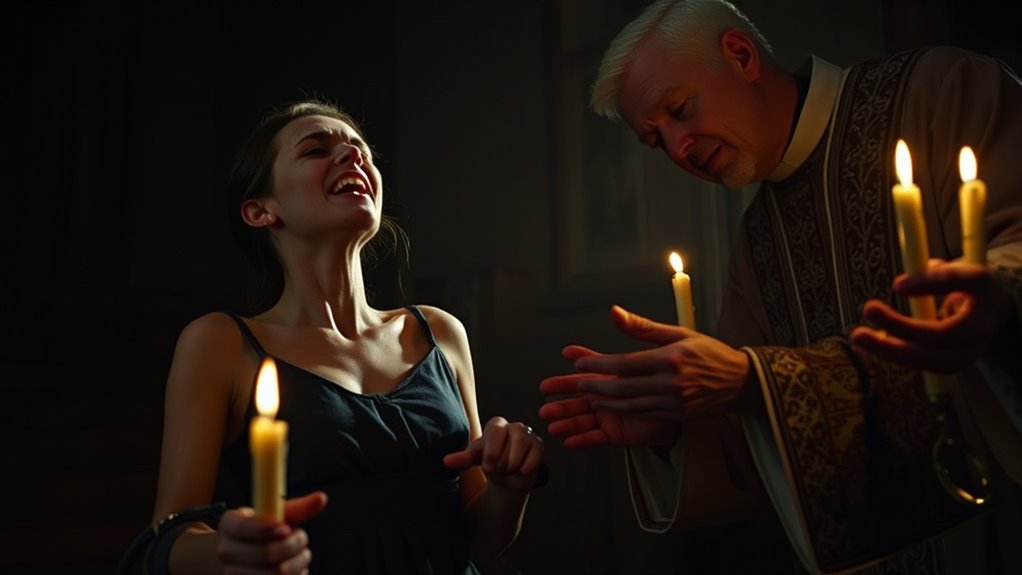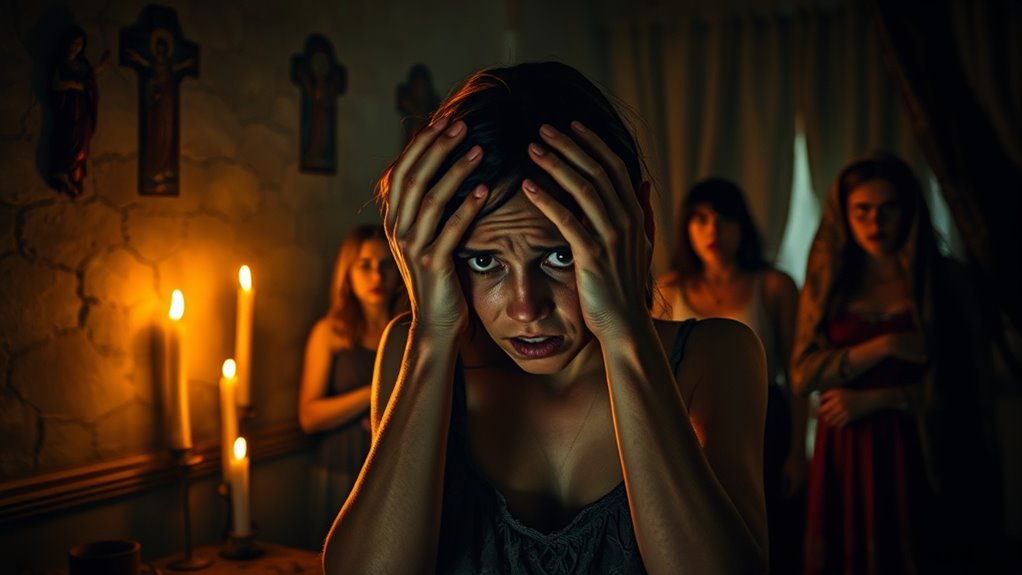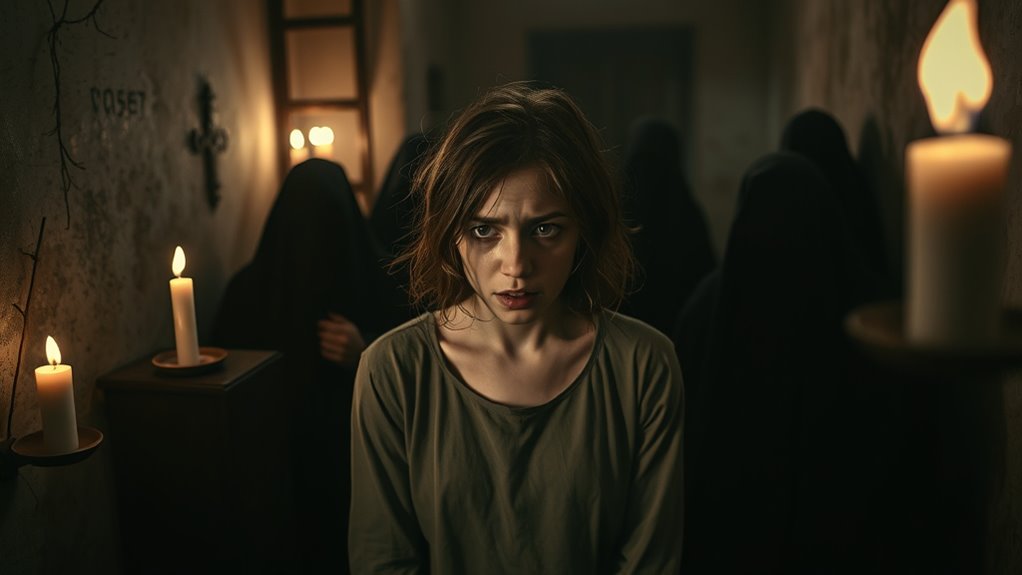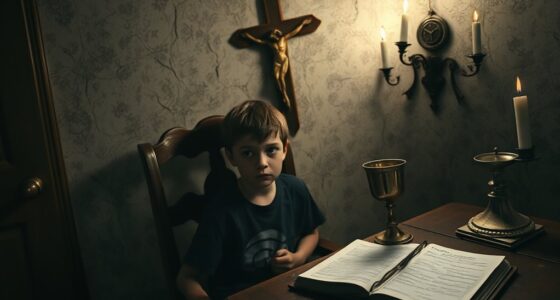The exorcism of Anneliese Michel is a tragic case where her severe mental health symptoms were believed to be demonic possession. Raised in a devout Catholic family, her behaviors worsened despite medical care, leading her family and priests to perform intense exorcisms. Controversy surrounds the case due to legal battles, ethical concerns, and media sensationalism, blurring the lines between faith and science. Explore further to understand the complex events behind her story and the debates it sparked.
Key Takeaways
- Anneliese Michel was a German woman who underwent multiple exorcisms due to her severe psychiatric and spiritual symptoms.
- Her case involved intense religious rituals aimed at casting out demonic possession, blending spiritual and medical explanations.
- The exorcisms were performed by priests without proper medical oversight, leading to her tragic death in 1976.
- Legal and ethical controversies arose over her treatment, with accusations of neglect and misuse of exorcism practices.
- Her story inspired films and media portrayals, fueling debates on faith, mental health, and the limits of exorcism.
Anneliese Michel’s Early Life and Background

Anneliese Michel was born on September 21, 1952, in Leiblfing, Germany. Growing up, her early life was shaped by the cultural influences of a devout Catholic family, which deeply impacted her worldview. As you explore her background, consider how her environment might have influenced her psychological assessment later in life. Her religious upbringing emphasized faith and spiritual beliefs, possibly affecting her perception of mental health and supernatural phenomena. These cultural factors played a significant role in how she interpreted her experiences and sought help. Understanding her early environment helps you see why her case became intertwined with religious beliefs, shaping her responses to her symptoms and the subsequent events that unfolded. The psychological factors involved in her case are complex and influenced by her upbringing and belief system. Additionally, her case highlights the importance of considering cultural influences when evaluating mental health and spiritual experiences. Furthermore, the increasing automation in business during her era reflects how technological and societal shifts can impact individual perceptions and societal responses to unexplained phenomena. Recognizing the influence of mental health assessment practices of the time can also shed light on how her case was interpreted and managed. Moreover, her case underscores the importance of understanding personal belief systems in evaluating mental health and spiritual experiences.
The Onset of Symptoms and Initial Diagnoses

As her religious upbringing shaped her worldview, her initial experiences soon raised concerns that prompted her to seek medical and spiritual help. She began exhibiting strange behaviors—screaming, hallucinations, and physical tremors—that many believed pointed to demonic possession. However, her symptoms also aligned with mental health issues like epilepsy or psychosis. Her family and doctors struggled to determine the cause, debating whether she was suffering from a mental health disorder or something more sinister. Despite medical treatments, her condition worsened, with episodes of violent outbursts and unexplainable physical phenomena. This ambiguity led to a complex diagnosis process, where both mental health and spiritual explanations were considered, setting the stage for her tragic journey toward exorcism. The contrast ratio of her symptoms’ severity further complicated the diagnosis, as clinicians tried to differentiate between neurological and spiritual causes. In regions where Western influences and local customs intersect, such as in some urban areas, families might be more receptive to exploring both medical and spiritual interventions for such conditions. Additionally, understanding the mind-body connection can be crucial in comprehending the complexities of cases like hers. Recognizing the role of essential oils and natural remedies in holistic health might offer alternative support options in some contexts. Exploring traditional healing practices can sometimes provide additional insights into culturally rooted perceptions of mental health.
The Spiritual Crisis and Search for Help

Convinced that her symptoms signaled a spiritual affliction, her family and community began to see her distress as a battle against evil rather than a medical issue. They sought various forms of help, believing conventional treatments failed to address her suffering. You might consider:
Her family saw her distress as spiritual darkness needing divine intervention over medical help.
- Pursuing psychological therapy to explore possible mental health causes.
- Seeking spiritual guidance from priests or religious leaders to combat perceived spiritual forces.
- Consulting medical professionals for comprehensive evaluations.
- Exploring alternative therapies that blend spiritual and psychological approaches.
- Relying on Paint Sprayer Reviews & Buying Guides to better understand effective tools for home improvement.
- Their focus shifted from standard medicine to faith-based interventions, hoping to find relief through prayer, blessings, or exorcism. This search reflected their deep conviction that her problem was rooted in spiritual darkness needing divine intervention. They also believed that understanding spiritual darkness was crucial for effectively addressing her condition, especially in light of the increasing role of AI in Business and technological influences that can affect perceptions of reality. Additionally, integrating meditation practices was seen as a way to foster inner peace and spiritual resilience amidst her struggles. Recognizing the importance of mental health awareness in such cases can help communities approach these crises with compassion and comprehensive support.
The Exorcism Rituals and Procedures

Exorcism rituals are carefully structured ceremonies designed to cast out perceived evil spirits from the afflicted individual. When confronting demonic possession, the priest acts as a spiritual intervention, using sacred rites to challenge the entity. The ritual often begins with prayers, blessings, and scripture readings, creating a protective spiritual boundary. The priest may command the demon to leave, invoking Jesus Christ’s name. The table below highlights key elements of these procedures:
| Step | Action | Purpose |
|---|---|---|
| Prayer | Recitation of sacred texts | Invoke divine authority |
| Blessing | Holy water and relics | Purify and protect |
| Command | Order the demon to depart | Spiritual intervention |
| Scripture Reading | Verses to confront evil | Strengthen faith |
| Final Blessing | Seal the ritual | Ensure demonic presence ends |
This process aims to restore spiritual balance and free the individual from evil’s grip. Spiritual intervention involves a combination of faith, authority, and ritual to effectively confront and dispel malevolent forces.
The Controversy and Legal Proceedings

You might wonder how the legal battles surrounding Anneliese Michel unfolded and what their outcomes were. These cases sparked intense debates over ethics and religious practices, challenging authorities and the church alike. Exploring these points reveals the complex tensions at play during this controversial period.
Legal Battles and Outcomes
The legal battles surrounding Anneliese Michel’s case have sparked intense debate and scrutiny. You’ll find that the case involved complex issues like custody battles and accusations of medical negligence. The court examined whether her parents and doctors acted responsibly during her treatment. Some argued that the church’s involvement influenced the tragic outcome, while others pointed to neglect in medical care. Key points include:
- Custody battles over her care and treatment decisions
- Allegations of medical negligence leading to her death
- The trial of her parents, who faced charges related to her death
- The role of religious authorities in the legal proceedings
Ultimately, the case resulted in convictions for her parents, but it also raised questions about the responsibilities of medical and religious authorities in such cases.
Ethical and Religious Debates
The legal battles surrounding Anneliese Michel’s case ignited widespread debate about the ethics and morality of exorcism practices intertwined with medical care. Many questioned whether her suffering resulted from demonic possession or medical conditions that needed treatment. Religious rituals like exorcisms, performed without proper medical oversight, raised concerns about consent and the potential harm caused by such practices. Critics argue that exorcisms can sometimes replace necessary medical intervention, risking the victim’s life. Supporters believe these rituals are crucial for spiritual healing. This controversy sparked legal proceedings that challenged the boundaries between religious freedom and medical ethics. Ultimately, the case forced society to confront the complex morality of exorcism, the legitimacy of demonic possession claims, and the role of religion in medical decisions.
The Aftermath and Public Reactions

After the tragic events, the case became a media sensation, sparking intense controversy and public interest. Many people still debate whether it was a genuine possession or a tragic misjudgment. Your opinions might differ, but these ongoing debates keep the story relevant today.
Media Sensation and Controversy
How did the media turn Anneliese Michel’s exorcism into a sensational spectacle? Media sensationalism amplified the story, blending tragic details with fear and intrigue. They highlighted her suffering, framing it as a battle between good and evil, influenced heavily by religious influence. This coverage sparked widespread curiosity and controversy. You might have noticed how the press:
- Exaggerated her mental health struggles as demonic possession
- Portrayed the priests as battling supernatural forces
- Used lurid headlines to attract readers
- Ignored nuanced medical explanations in favor of sensational stories
This sensationalism fueled public debate, blurring the lines between faith, mental health, and sensational entertainment. It transformed a personal tragedy into a media event that divided opinions and fueled controversy for years.
Ongoing Debates and Beliefs
Decades after Anneliese Michel’s exorcism, public reactions remain deeply divided, reflecting ongoing debates about faith, mental health, and the truth behind her story. Some believe her experiences point to supernatural phenomena, viewing her case as evidence of real demonic possession. Others, guided by scientific skepticism, argue her symptoms were rooted in mental illness, emphasizing the importance of medical treatment over spiritual rituals. This divide fuels continued discussions about the limits of faith-based interventions and the legitimacy of exorcisms. As new generations learn about her story, these debates persist, challenging perceptions of reality, mental health, and divine intervention. Ultimately, her case remains a potent symbol for both believers and skeptics, sparking conversations that bridge faith and science.
The Impact on Mental Health and Religious Communities

The exorcism of Anneliese Michel profoundly affected both mental health perspectives and religious communities by highlighting the complex overlap between psychological disorders and spiritual beliefs. This case sparked debates about how mental health issues are interpreted through religious influence. You might notice how some view her symptoms as demonic possession, leading to spiritual interventions, while others see mental illness requiring medical treatment. The controversy encouraged mental health professionals to contemplate cultural and religious contexts when diagnosing. It also prompted religious communities to reevaluate their role in such cases. Key impacts include:
- Increased awareness of mental health in religious settings
- Criticism of exorcism practices affecting vulnerable individuals
- Reevaluation of the boundaries between faith and medicine
- Greater dialogue on integrating spiritual support with mental health care
Cultural Depictions and Media Coverage

Cultural depictions and media coverage of Anneliese Michel’s story have considerably shaped public perception of her case, often blending fact with fiction to create compelling narratives. Movies, documentaries, and books have dramatized her experience, emphasizing demonic possession and the intense exorcisms. Media dramatization amplifies her story’s horror, sometimes blurring reality and fiction, which influences how people view exorcisms and mental health. These depictions often focus on supernatural elements, fueling sensationalism. As a result, her story has become a cultural touchstone, inspiring horror films like “The Exorcism of Emily Rose.” Below is a visual summary of how media portrays her case:
| Aspect | Media portrayal |
|---|---|
| Focus | Demonic possession and supernatural phenomena |
| Tone | Dramatic, sensational, often exaggerated |
| Impact on perception | Fosters fear, skepticism, and curiosity about exorcisms |
Ongoing Debates: Faith, Psychology, and Ethics

Media portrayals of Anneliese Michel’s case have shaped public perceptions, often emphasizing supernatural elements and sensational stories. This fuels ongoing debates about faith versus science, morality, and authority. Some argue her case highlights the power of religious faith in confronting mental health issues, while others see it as a failure of scientific understanding and medical intervention.
Consider these points:
- How do we balance faith and science when diagnosing mental illness?
- Who holds moral authority in cases involving spiritual practices?
- Should religious beliefs override psychological explanations?
- Where do we draw the line between ethical exorcisms and abuse?
You’re left questioning whether morality and authority should prioritize spiritual beliefs or scientific evidence in such complex situations.
Frequently Asked Questions
What Was Anneliese Michel’S Life Like Before Her Illness Began?
Before her illness, you’d see Anneliese Michel growing up in a devout Catholic family, where faith played a central role. Her childhood experiences included attending church regularly and showing strong religious beliefs. She was known to be a thoughtful and caring girl, shaped by her family’s values. Life was stable and centered around her faith, which deeply influenced her early years before her health challenges began.
How Did the Exorcism Rituals Differ From Traditional Catholic Rites?
You might find it intriguing that exorcism rituals differ from traditional Catholic rites because they involve specific procedures for demonic possession. Ritual details include commanding spirits to leave, using holy water, and invoking Jesus’s name. Unlike standard rites, exorcisms focus on confronting evil directly, often with longer, more intense prayers. These rituals aim to free the person from demonic influence, emphasizing spiritual battle rather than sacraments alone.
Were There Alternative Treatments Considered Before the Exorcism?
Before proceeding with an exorcism, you might wonder if other options were considered. Typically, medical therapy and psychiatric evaluation are first attempted to address mental health issues. In Anneliese’s case, her family and clergy may have initially explored these treatments, but when symptoms persisted, they opted for an exorcism. This highlights how, at times, spiritual interventions are prioritized over medical or psychiatric approaches.
What Were the Long-Term Psychological Effects on Those Involved?
You might wonder about the long-term psychological effects on those involved. They often experience psychological trauma from the intense events, feeling guilt, fear, or confusion. The spiritual aftermath can leave them questioning their beliefs or feeling spiritually drained. These lasting impacts may influence their mental health and outlook on life, highlighting how deeply such experiences can affect a person’s emotional and spiritual well-being long after the event ends.
How Has the Case Influenced Modern Exorcism Practices?
Ever wonder if demon possession really calls for a Hollywood-style showdown? Today, exorcism protocols are far more cautious, blending psychology with tradition. This case’s notoriety pushes practitioners to question sensational rituals, favoring evidence-based methods over spectacle. You can thank this controversy for modern exorcisms being less about dramatic flair and more about careful discernment. So, next time you hear about a demon, remember, science might just be the new exorcist.
Conclusion
Imagine standing at a crossroads where faith and science collide, each beckoning you with promises of salvation or understanding. Anneliese Michel’s story is like a fragile glass shattering under pressure—revealing the raw tension between belief and mental health. Her tragic case reminds you that sometimes, what looks like darkness might be a cry for help, urging us to look deeper and question where compassion truly begins. It’s a haunting reminder of the thin line we walk.









